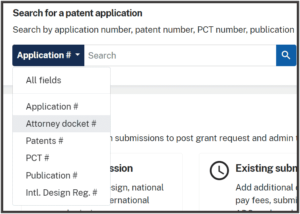
In a previous blog article I discussed the front-page attorney docket number search in Patentcenter. I pointed out that in the legacy system (PAIR) it was possible to check a box to enter a partial docket number to get one or more matches. In that previous blog article I noted the conspicuous absence of a corresponding check box in Patentcenter’s front-page attorney docket number search. I am indebted to alert reader Marc V Richards for somehow figuring out that there is an undocumented feature that sort of makes up for the absence of that check box. It turns out that you can do wildcard searches.
Marc V. Richards is an experienced patent practitioner with Crowell & Moring in Chicago.
Some readers are familiar with the various ways that the designers of search functions will permit truncation. One might use a question mark to truncate. Another might use an exclamation point. Still another might use $ as the truncation system. Finally, some designers use an asterisk.
It turns out that the USPTO developers of Patentcenter picked the asterisk for their undocumented front-page docket number search function. Indeed you can place it before your partial docket number, or after it, or both before or after it, to do a search. So for example *1141* will find all files where “1141” appears anywhere in the docket number.

In PAIR, you can’t miss the check box. The instant that you click to do a front-page docket number search, a screen expansion happens that makes clear that one of the user options is “starts with”. See the screen shot at right. In contrast, so far as I know the only way to know of this wildcard feature in Patentcenter is to have the good luck to know Marc V Richards (or to know someone who knows him).
What do readers think? Does this undocumented feature permit the USPTO claim victory over the CP12 bug? Or will the USPTO actually have to document the feature somewhere the users would naturally find it, to be able to take credit for clearing the CP12 bug? Please post a comment below.

Asterisk is a traditional wildcard character in software engineering, typically with a meaning of “one or more characters,” as opposed to question mark (or some other wildcard character) with a meaning of “exactly one character.”
Being able to include a wildcard character at the beginning and/or end of a partial attorney docket number is better than “Starts with,” i.e. only at the end of a partial attorney docket number.
So, Patentcenter provides a wildcard capability that is a superset of PAIR and, therefore, meets the goal of bringing forward the wildcard feature of PAIR.
Of course, a lack of documentation of this feature and how to use it poses a problem. It does not seem as though the USPTO promised to document how to use the features of Patentcenter that it brings forward from PAIR.
I use computers as a highly versatile tool, but I am not a computer scientist. As such I am a fan of well-designed graphical user interfaces. Both interfaces should be included.
I think it’s fair to say CP12 is fixed, but that there is another problem, which is the solution is an undocumented feature. As long as it’s undocumented, the PTO could take the feature away without warning.
If it ain’t documented and made known to users by the PTO, it ain’t fixed.
The USPTO web interfaces are replete with special format requirements that are documented and strictly adhered to. Is the asterisk a feature that can be used as a wild card in other contexts? We should not be required to experiment.
Thanks Marc.
I was surprised to find that the attorney docket number search is case-sensitive. This is the same behavior as EFS, but seems like an unhelpful requirement.
As with the undocumented wildcard, it would be tremendous to have something (even a tooltip) that indicates that the search is case-sensitive.
Believe it or not, some law firms use case-sensitive docket numbers. I once worked for a law firm that coded the jurisdiction into a docket number. Lower case Q (i.e., “q”) designated provisional patent applications, whereas upper case Q designated something else! It was a terrible idea, but some people don’t realize that docket numbers are merely serial numbers and should not include intelligence, beyond simply identifying a case. This is basic database design best practice. Including intelligence within a serial number creates a system that begs to be broken when, for example, some new requirement comes along (like the introduction of provisional patent applications) that requires adding something to an existing numbering scheme.